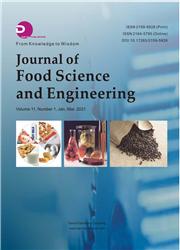Production and Evaluation of Table Wine Using Two Different Varieties of Pawpaw (Carica papaya)
引用次数: 5
Abstract
The aim of this study was to produce and evaluate table wine from two different varieties of pawpaw (rose red and yellow pawpaw). The must was evaluated for physicochemical and microbiological changes during fermentation while the wine was analyzed for physicochemical characteristics, microbiological quality and sensory properties and compared with commercial grape wine. Specific gravity of the “must” during fermentation decreased from 1.059-0.995 for rose red pawpaw and 1.005-0.990 for yellow pawpaw. The sugar content decreased from 13-3% on the 14th day of fermentation for rose red pawpaw while yellow pawpaw “must” decreased from 12.5-3%. pH drop for the yellow pawpaw “must” was 4.7-3.4 on the 14th day and 4.0-3.4 for rose red pawpaw “must”. Titratable acidity of the pawpaw “must” increased from 0.16-0.32% for rose red pawpaw “must” and 0.20-0.52% for yellow pawpaw “must”. Microbial analysis of the “must” during fermentation showed that yeast count increased from no growth to 3.0 × 10 cfu/mL for yellow pawpaw must and 4.0 × 10 cfu/mL for rose red pawpaw, respectively while total bacterial count decreased from 5.4 × 10-l.5 × 10 cfu/mL for yellow pawpaw must and 5.2 × 10-1.2 × l0 cfu/mL for rose red pawpaw “must”. Coliform recorded no growth throughout the period of fermentation. Physicochemical analysis of the wine showed that the yellow pawpaw wine has a specific gravity of 0.999, alcohol content 8.00%, titratable acidity of 0.59%, pH of 3.5 and sugar content of 3%. The rose red pawpaw wine had sugar content of 3%, titratable acidity of 0.38%, alcohol content 7.69%, specific gravity 0.997 and pH of 3.5. Microbial analysis of the wine showed no growth of coliform and yeast while bacterial count was 1.0 × 10 cfu/mL for both wines. Sensory results for the pawpaw wine showed no significant (p > 0.05) difference in the clarity and overall acceptability from the commercial wine.用两个不同品种的木瓜生产餐桌酒及其评价
本研究的目的是用两种不同品种的木瓜(玫瑰红木瓜和黄木瓜)生产和评价餐酒。对发酵过程中的理化和微生物变化进行了评估,同时对葡萄酒的理化特性、微生物质量和感官特性进行了分析,并与商业葡萄酒进行了比较。发酵过程中“必须”的比重从玫瑰红木瓜的1.059-0.995下降到黄色木瓜的1.005-0.990。玫瑰红木瓜发酵第14天的含糖量从13-3%下降,而黄木瓜“必须”从12.5-3%下降。“必须”木瓜的可滴定酸度从玫瑰红木瓜的0.16-0.32%增加到黄色木瓜的0.20-0.52%。发酵过程中对“必须”的微生物分析表明,黄木瓜的酵母计数从无生长增加到3.0×10 cfu/mL,玫瑰红木瓜的酵母数分别增加到4.0×10 cfu/mL,而黄木瓜的总细菌计数从5.4×10。大肠杆菌在整个发酵过程中没有生长。物理化学分析表明,木瓜黄酒的比重为0.999,酒精含量为8.00%,可滴定酸度为0.59%,pH值为3.5,含糖量为3%。玫瑰红木瓜酒的糖含量为3%,可滴定酸度为0.38%,酒精含量为7.69%,比重为0.997,pH为3.5。对葡萄酒的微生物分析显示,两种葡萄酒的大肠菌群和酵母均未生长,细菌计数均为1.0×10 cfu/mL。木瓜酒的感官结果显示,与商业葡萄酒相比,木瓜酒的澄清度和整体可接受性没有显著差异(p>0.05)。
本文章由计算机程序翻译,如有差异,请以英文原文为准。
求助全文
约1分钟内获得全文
求助全文

 求助内容:
求助内容: 应助结果提醒方式:
应助结果提醒方式:


